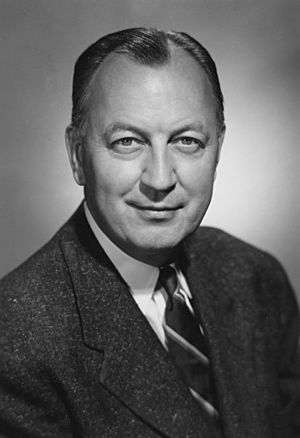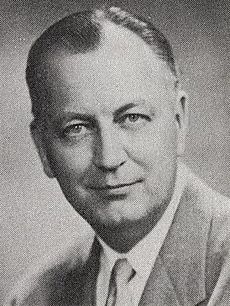Elmer L. Andersen facts for kids
Quick facts for kids
Elmer L. Andersen
|
|
|---|---|

Andersen as Governor
|
|
| 30th Governor of Minnesota | |
| In office January 2, 1961 – March 25, 1963 |
|
| Lieutenant | Karl Rolvaag |
| Preceded by | Orville Freeman |
| Succeeded by | Karl Rolvaag |
| Member of the Minnesota Senate from the 42 district |
|
| In office February 2, 1949 – January 5, 1959 |
|
| Preceded by | Claude Henry Allen |
| Succeeded by | Clifton T. Parks |
| Personal details | |
| Born |
Elmer Lee Andersen
June 17, 1909 Chicago, Illinois, U.S. |
| Died | November 15, 2004 (aged 95) Minneapolis, Minnesota, U.S. |
| Political party | Republican |
| Spouse |
Eleanor Johnson
(m. 1932) |
| Profession | businessman, philanthropist |
Elmer Lee Andersen (June 17, 1909 – November 15, 2004) was an American businessman, a generous giver (philanthropist), and a politician. He built a very successful business called the H. B. Fuller Company. Andersen is best known as the 30th governor of Minnesota. He was a Republican, but he was known for being a moderate, meaning he held balanced views. He helped pass many important laws about social issues and protecting the environment.
In one of the closest elections in the history of Minnesota and the United States, Andersen lost the 1962 Minnesota gubernatorial election by only 91 votes to Karl Rolvaag.
Contents
Early Life & Education
Andersen was born in Chicago, Illinois. His mother, Jennie Olivia Johnson, came from Sweden. His father, Arne Kjelsberg Andersen, was an immigrant from Norway. He worked as a streetcar driver. Elmer remembered riding the streetcar with his dad and ringing the bell.
When Elmer was six, his parents separated. He, his mother, and his baby sister moved to Muskegon, Michigan. His older brothers joined them later. When Elmer was nine, he got a mild form of polio, but he got his strength back through exercise.
First Jobs & Learning
Elmer's first job was helping his mother with laundry. Then he sold newspapers, vegetables, and candy. He also carried bags for travelers. He loved selling and talking to people. He believed a good salesman could influence others.
At age 14, Elmer started working with his brothers at E. H. Sheldon and Company. This company made special furniture for schools. He also wrote short articles about birds for the Muskegon Chronicle newspaper. Seeing his words in print made him love the newspaper business.
His mother was very involved in their Lutheran church. She made sure her children were raised in the church. In 1925, his mother died from pneumonia. His father died within a year from a heart attack.
College & Early Career
Andersen graduated from high school in 1926. He was in the first class of the new Muskegon Junior College. He received the first diploma from the school two years later. While in college, he worked in real estate and as a reporter for the Muskegon Chronicle. He also started a newspaper for his junior college.
Soon after, he and his brothers started their own company, Muskegon Realty. They sold homes, farms, and insurance. Andersen said he grew up quickly during these years. He was learning many new things.
After junior college, he worked as a salesman for the Sheldon Company in Minneapolis, Minnesota. He wanted more from life. He decided to go to the University of Minnesota. He had three goals: get a degree for job security, find a wife, and have fun. He graduated from the University of Minnesota in 1931.
H. B. Fuller Company
In 1934, Andersen joined the H. B. Fuller Company in St. Paul, Minnesota. This company made school paste. He managed sales for seven years. In 1941, he bought most of the company and became its president.
Under his leadership, the company became a leader in corporate responsibility. This means they cared about their employees and the community. They offered good benefits to employees, their spouses, and retired workers.
Andersen's Business Philosophy
Andersen had four main priorities for his company:
- First: Serve the customer. They wanted to provide whatever the customer needed.
- Second: Benefit the people who worked there. He called employees "associates" to show everyone was equal.
- Third: Make money. A company needs money to survive, grow, and create new products.
- Fourth: Serve the larger community. He believed businesses should care about society.
Under Andersen, Fuller grew from a small company to an international Fortune 500 company. They expanded by opening smaller plants in many different markets. This helped them keep costs down and offer good prices. By 1970, Fuller was a leader in the adhesives industry. They had 27 plants in the U.S. and ten in other countries. Andersen retired in 1974, at age 65. His oldest son, Tony, took over the company.
Other Businesses & Interests
Dairy Farm
In 1953, Andersen also started a dairy business. He bought a farm near St. Croix Falls, Wisconsin. He had about 200 cattle. His farm, Deer Lake Farm, won an award in 1984 for its Holstein cows. He also worked on environmental projects on the farm. When he left the dairy business in 1988, he set aside 80 acres of land as a preserve.
ECM Publishers
In 1974, Andersen began a new career as a newspaper publisher and writer. He bought two newspapers to form the Princeton Union-Eagle. This eventually became part of ECM Publishers, which published many local weekly newspapers. Andersen wrote editorials for these papers. He said his newspaper work gave him great personal satisfaction. He wanted his editorials to make readers think, not tell them what to think. The Andersen family sold ECM in 2016.
Political Career
Andersen was a progressive Republican. This means he was a Republican who supported social programs and environmental protection. He served in the Minnesota legislature from 1949 to 1958.
Key Achievements in Legislature
He supported many important causes, including:
- Educational programs for children with special needs.
- The Metropolitan Planning Commission for the Twin Cities.
- The Fair Employment Practices Act. This law helped prevent unfair treatment in jobs. Minnesota was the fifth state to pass such a law. Andersen said one of his most touching memories was when an African-American man thanked him, saying he felt like a "real man" because of the anti-discrimination bill.
Governor of Minnesota
In 1960, Andersen ran for governor against the current governor, Orville Freeman. Andersen won by over 20,000 votes. During his time as governor, several important things happened:
- The common loon became Minnesota's state bird.
- Several new state parks were created.
- The Taconite Amendment and fair housing laws were passed.
He lost his re-election two years later by the closest margin in U.S. history. The election was on November 6, 1962, but the results were not known until March 21, 1963. After many recounts and court challenges, it was found that Karl Rolvaag had beaten Andersen by only 91 votes out of nearly 1.3 million votes.
Andersen remained a Republican, but he became unhappy as the party grew more conservative. In 2003, he said he wanted to be known as a "liberal Republican." In the 2004 presidential election, he supported the Democratic candidate, John Kerry. He even wrote an article criticizing President George W. Bush and Vice President Dick Cheney. Unlike many in his party, Andersen did not support low taxes.
University of Minnesota
Andersen was very involved with the University of Minnesota. He served on its Board of Regents from 1967 to 1975. He was the chair from 1972 to 1975. He also helped raise money for the university. From 1985 to 1988, he played a big role in the most successful fundraising effort by any U.S. public university at that time.
Andersen believed that universities should also preserve history and important documents. The building that holds the university's archives and special collections is named after him. It is called the Elmer L. Andersen Library, and it opened in April 2000.
Voyageurs National Park
One of Andersen's proudest achievements was helping to create Voyageurs National Park in April 1975. This park protects thousands of acres of forests and lakes along Minnesota's northern border. Andersen, along with others like naturalist Sigurd Olson and aviator Charles Lindbergh, worked for many years to convince people of the park's importance. He is remembered as the "father of Voyageurs National Park."
He said that many people helped make the park a reality. He especially thanked Charles Lindbergh for his help in preserving the wilderness.
Book Collector
Andersen loved books from a young age. He collected them his whole life. As a young traveling salesman, he saved his money to buy books. He wanted to read them, learn about them, and care for them. He was interested in American and English history, literature, and poetry. When he moved to Minnesota, he became interested in the state's history.
He also wrote a column about book collecting for his Princeton Union-Eagle newspaper. He used the pen name Arne Kjelsberg, which were his father's first two names. He kept his authorship a secret for many years.
Andersen's wife, Eleanor, supported his love for books. They often bought books together and also gave many books to libraries. They were major supporters of the University of Minnesota and its libraries. The Minnesota Landscape Arboretum Library is named after Andersen because of their generosity. In 1999, he gave his personal library of 12,500 rare books to the University of Minnesota. This was called a "gift of the heart."
Personal Life & Legacy
Andersen met Eleanor Anne Johnson at church when they were both students. They married on September 1, 1932. Eleanor left the university to get married, but she later earned her degree. Andersen often said his wife helped him achieve many of his successes. They had three children.
Andersen wrote several books, including his autobiography, A Man's Reach. He also wrote a collection of newspaper articles and a guide to the Minnesota state capitol building.
The Elmer L. and Eleanor J. Andersen Foundation was started in 1957. This foundation helps support many good causes.
Elmer L. Andersen died in Minneapolis on November 15, 2004. He was 95 years old. The Minnesota Department of Human Services Building in St. Paul is also named after him.


